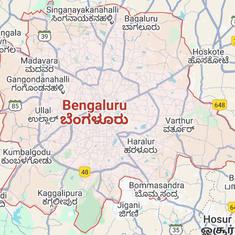With his unreliable grasp of facts, perhaps Modi would prefer to forget that the 1857 uprising united Hindu and Muslim rebels to reinstall a Muslim emperor on the throne. That year, much of India was ruled by the British. While there were sporadic uprisings all over British regions, very few saw sustained battles.
Here are some engravings and archival photographs that tell the story of 1857.
February 1857
There was unrest in the 19th Bengal Native Infantry in Berhampur in West Bengal after rumours spread that new cartridges, which soldiers had to bite open before the gunpowder could be slipped into musket barrels, had been smeared with pork fat and beef tallow. This was unacceptable to both Muslims and Hindus. The regiment was disarmed. Mangal Pandey led a revolt in Meerut in May. Bahadur Shah Zafar, last of the Mughals, was declared India's emperor.

Disarming the 11th Irregular Cavalry at Berhampore, steel engraving, 1858
June 1857
Nana Sahib, the adopted son of Maratha king Peshwa Baji Rao II, led the siege of Kanpur. Despite promising safe passage down the Ganga to those British civilians trapped in the city, his troops opened fire and captured women and children. He allegedly ordered them killed a month later.

Massacre at Satichura Ghat, steel engraving, c1857
September 1857
Delhi was recaptured by British forces. Bahadur Shah Zafar was arrested and his sons summarily executed. The last Mughal would later be divested of his title and sent in exile to Burma.

Delhi with a view of Shahjahanabad and the Jamuna, 1858
March 1858
The British regained Lucknow after a series of battles and looted the city. They continued campaigns against Awadh, Jhansi and Gwalior.

British soldiers looting Quaisar Bagh, Lucknow, steel engraving, 1858
May 1858
Rani Laxmibai of Jhansi, Rao Sahib of Gwalior, the Raja of Banda and Tatya Tope gathered for battle at Gwalior. Together, they led the fight from central India. They were routed.

Tatya Tope and his troops, 1857
June 1858
“The Ranee of Jhansi, The India Joan of Arc was killed…dressed in a red jacket, red trousers, and white puggary…The whole rebel army mourned for her. Her body was burnt with great ceremony under a tamarind tree, under the rock of Gwalior ” - Sir Hugh Rose in a letter to the Duke of Cambridge.

Portrait of Lakshmibai, the Ranee of Jhansi, c1858
November 1858
Queen Victoria issued a proclamation transferring control over India from the East India Company to the Crown. She also issued a general amnesty to all rebels not directly guilty of murdering British citizens.

Queen Victoria's proclamation, 1858
April-July 1859
Tatya Tope was betrayed and executed. British reprisals against mutineers were variously gruesome and bloody.

Two sepoys of the 31st Native Infantry, who were hanged at Lucknow, 1859










